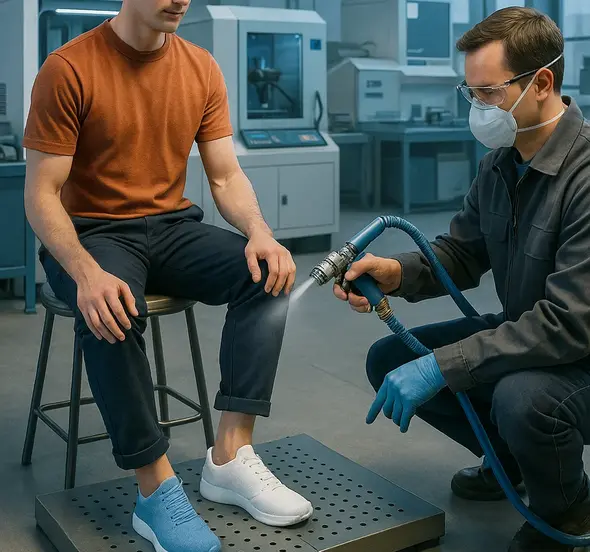Swiss Innovation Disrupts Traditional Footwear Production with Groundbreaking LightSpray Technology
In a remarkable leap forward for athletic footwear, Swiss company On has unveiled a revolutionary shoe manufacturing technology that could fundamentally transform how running shoes are made. Called “LightSpray,” this groundbreaking process uses robotic spray guns to create high-performance sneakers in just minutes, dramatically reducing production time while enhancing sustainability.
The innovative approach, developed at On’s Zurich headquarters, creates the upper part of a running shoe in just three minutes—a fraction of the time required for traditional manufacturing methods. This technological breakthrough represents one of the most significant advancements in footwear production in decades and signals a potential shift in how athletic shoes will be manufactured in the future.
How LightSpray Works: Reimagining Shoe Production from the Ground Up
From 200 Steps to Just a Handful
Traditional sneaker production involves approximately 200 steps and requires extensive manual labor across global supply chains. On’s revolutionary shoe manufacturing technology streamlines this complex process into just a handful of automated steps, creating a more efficient and localized production model.
“A traditional product is usually touched by approximately 200 hands, which is very, very different here,” explains an On representative. “It allows us to produce an upper material in a completely automated way.”
The Robotic Spray Process
The LightSpray process begins with a running sole manufactured at On’s lab, which is attached to a foot mold. A mile-long synthetic material called polymer is then sprayed onto the mold by a robot arm, requiring no glue, seams, or laces. Within seconds, the material solidifies, forming the upper part of the shoe.
The newly formed shoe then moves to another robot for logo application in what resembles a screen printing facility. This revolutionary shoe manufacturing technology eliminates many of the labor-intensive steps of traditional footwear production while creating a seamless, lightweight product.
On’s Market Growth: Challenging Industry Giants
Consistent Performance in a Competitive Market
Since going public in 2021, On has demonstrated impressive growth, with net sales increasing in 11 out of the past 13 quarters. This consistent performance has positioned the Swiss company as a serious challenger to established industry leaders like Nike and Adidas. The company’s focus on revolutionary shoe manufacturing technology has given it a competitive edge in an industry where innovation drives consumer interest.
Backed by tennis legend Roger Federer, On has leveraged its Swiss engineering heritage to develop products that appeal to performance-oriented athletes and style-conscious consumers alike. The LightSpray technology represents the company’s most ambitious innovation yet, potentially reshaping the athletic footwear landscape.
Expanding Production Capacity
To capitalize on the potential of its revolutionary shoe manufacturing technology, On recently announced the opening of its first-ever LightSpray factory in Switzerland. The facility features four additional robots dedicated to scaling up production of these innovative shoes.
“What we want to be able to do is to bring it from a couple of thousand pairs to millions of pairs,” states an On executive, highlighting the company’s ambitious production goals. This manufacturing expansion represents a significant investment in the technology’s future and signals On’s confidence in its market potential.
Product Innovation: The Cloud Boom Strike LZ
Featherlight Performance
Launched in 2024, the Cloud Boom Strike LZ was On’s first shoe featuring the LightSpray technology. Weighing just 170 grams (approximately one-third of a pound), the shoe delivers an exceptionally lightweight running experience that early users describe as “floating.”
The shoe’s minimal weight and seamless construction contribute to its performance capabilities, making it particularly appealing to competitive runners seeking every possible advantage. At $330, the Cloud Boom Strike LZ positions itself in the premium performance category, with limited release drops creating additional exclusivity and demand.
Competitive Success
The revolutionary shoe manufacturing technology has already made its mark in competitive running. Helen Obree wore an early model of the LightSpray shoes when she won the Boston Marathon in 2020, providing a high-profile showcase for the technology’s performance benefits.
This kind of elite athletic success helps validate On’s technological approach and positions the LightSpray shoes as serious performance tools rather than merely innovative curiosities. As more professional athletes adopt the technology, On stands to gain additional credibility in the competitive running market.
Sustainability Advantages of LightSpray Technology
Reduced Carbon Footprint
Beyond its production efficiency, On claims that its revolutionary shoe manufacturing technology delivers significant environmental benefits. According to the company, the LightSpray process reduces carbon emissions by approximately 75% compared to conventional shoe manufacturing methods.
This sustainability advantage stems from several factors, including reduced material waste, fewer chemical adhesives, and the potential for localized production that minimizes transportation impacts. As consumers increasingly factor environmental considerations into their purchasing decisions, this aspect of the technology could prove particularly valuable for On’s market positioning.
Reshoring Potential
One of the most significant long-term implications of the LightSpray technology is its potential to reshape global supply chains in the footwear industry. Traditional shoe manufacturing has been heavily concentrated in Asia due to labor cost advantages, but On’s revolutionary shoe manufacturing technology could make localized production economically viable.
“It allows us to produce where the consumer is,” explains an On representative. “This is eventually a possibility to bring production of the range to countries like the US.” This reshoring potential could reduce shipping-related emissions while creating manufacturing jobs in consumer markets—a compelling combination of economic and environmental benefits.
Hiring?
Post jobs for free with WhatJobs – Connect with innovative footwear technology professionals!
Post Jobs NowThe Origin Story: From Halloween Inspiration to Manufacturing Innovation
Unexpected Creative Spark
Innovation often emerges from unexpected sources, and On’s revolutionary shoe manufacturing technology is no exception. According to company lore, the initial inspiration for LightSpray came after an employee watched a Halloween video featuring a hot glue gun creating a spider web.
This creative spark led to years of research and development to transform a simple concept into a viable manufacturing process. The story highlights the importance of creative thinking and cross-disciplinary inspiration in developing breakthrough technologies.
R&D Investment
On’s commitment to innovation is reflected in its significant investment in research and development. Nearly a third of the 1,100 employees at its headquarters work in R&D, focusing on technologies like LightSpray and other potential breakthroughs.
This substantial allocation of human resources to innovation activities underscores the company’s strategy of competing through technological differentiation rather than scale or marketing alone. For a relatively young company challenging established industry giants, this innovation-focused approach provides a path to carving out a distinctive market position.
Future Applications: Beyond Running Shoes
Expanding the Product Range
While the initial application of LightSpray focuses on high-performance running shoes, On sees broader potential for its revolutionary shoe manufacturing technology. The company describes future applications as “wearables,” suggesting that the spray-on approach could extend to other footwear categories or even different types of apparel.
This expansion potential represents a significant growth opportunity for On, allowing it to leverage its technological investment across multiple product categories. The versatility of the spray-on approach could enable rapid prototyping and customization options that would be difficult to achieve with traditional manufacturing methods.
Customization Possibilities
The automated, digital nature of the LightSpray process opens intriguing possibilities for product customization. While not explicitly mentioned in current descriptions, the technology’s computer-controlled application process could theoretically allow for personalized fit and design features based on individual customer data.
Such customization capabilities would align with broader industry trends toward personalized products and could provide On with another competitive advantage in the premium footwear market. The combination of revolutionary manufacturing technology with personalization features could create compelling value propositions for consumers willing to pay premium prices.
Industry Implications: A Manufacturing Paradigm Shift?
Potential Disruption of Traditional Supply Chains
If On’s revolutionary shoe manufacturing technology proves scalable and economically viable, it could potentially disrupt established footwear industry supply chains. Traditional shoe manufacturing relies on labor-intensive processes distributed across global networks, with components often produced in multiple countries before final assembly.
The LightSpray approach consolidates much of this process into a single, automated workflow that could operate economically in high-wage countries. This consolidation could reduce complexity, lead times, and transportation costs while increasing responsiveness to market trends.
Competitive Response
On’s innovation is likely to prompt responses from established footwear giants, who have their own advanced manufacturing initiatives. Nike’s Flyknit technology and Adidas’s 3D-printed midsoles represent previous efforts to revolutionize aspects of shoe production, but neither has attempted the comprehensive manufacturing reinvention that On’s LightSpray represents.
How quickly competitors can develop comparable technologies—or alternative innovations that deliver similar benefits—will significantly influence the long-term impact of On’s approach on the broader industry. The coming years may see an acceleration of manufacturing innovation as companies race to develop the next generation of footwear production technologies.
FAQ: Understanding Revolutionary Shoe Manufacturing Technology
What makes LightSpray a revolutionary shoe manufacturing technology compared to traditional methods?
LightSpray represents a revolutionary shoe manufacturing technology because it reduces the traditional 200-step process to just a handful of automated steps. Unlike conventional shoe production that requires approximately 200 hands to touch each product, the LightSpray method uses robotic spray guns to create the upper part of a sneaker in just three minutes without glue, seams, or laces. This revolutionary shoe manufacturing technology not only dramatically speeds up production but also reduces carbon emissions by approximately 75% compared to traditional methods.
How does On’s revolutionary shoe manufacturing technology impact sustainability in footwear production?
On’s revolutionary shoe manufacturing technology delivers significant environmental benefits by reducing carbon emissions by approximately 75% compared to conventional methods. This sustainability improvement comes from eliminating many resource-intensive steps in traditional production, reducing material waste, minimizing chemical adhesives, and enabling localized production that cuts transportation emissions. The revolutionary shoe manufacturing technology also creates possibilities for reshoring production to consumer markets like the US, further reducing the carbon footprint associated with global shipping of finished products.
What performance benefits do shoes made with this revolutionary shoe manufacturing technology offer?
Shoes produced using On’s revolutionary shoe manufacturing technology offer exceptional lightweight performance, with the Cloud Boom Strike LZ weighing just 170 grams (about one-third of a pound). The seamless, spray-on construction creates an upper that conforms closely to the foot without pressure points from seams or overlays. Athletes report a “floating” sensation when wearing these shoes, and the technology has already proven its competitive merit when Helen Obree won the 2020 Boston Marathon wearing an early version. The revolutionary shoe manufacturing technology allows for precise engineering of flexibility and support zones without the constraints of traditional construction methods.
How might revolutionary shoe manufacturing technology like LightSpray change the footwear industry in the future?
Revolutionary shoe manufacturing technology like LightSpray has the potential to fundamentally transform the footwear industry by enabling localized, automated production that reduces reliance on global supply chains and labor-intensive processes. This could lead to faster product development cycles, more responsive manufacturing that can quickly adapt to market trends, and new possibilities for customization. As the technology evolves, we may see revolutionary shoe manufacturing technology expand beyond running shoes to other footwear categories and even different types of wearable products, potentially reshaping how consumers think about and purchase athletic apparel.




